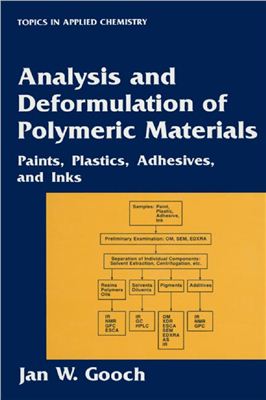New York / Boston / Dordrecht / London / Moscow: KLUWER ACADEMIC
PUBLISHERS, 2002. – 332 p.
This book is designed for the chemist, formulator, student, teacher, forensic scientist, or others who wish to investigate the composition of polymeric materials. The information within these pages is intended to arm the reader with the necessary working knowledge to analyze, characterize, and deformulate materials. The structure of the Contents is intended to assist the reader in quickly locating the subject of interest and proceed to it with a minimum of expended time and effort. The Contents provides an outline of major topics and relevant materials characterized for the reader’s convenience. An introduction to analysis and deformulation is provided in Chapter 1 to acquaint the reader with analytical methods and their applications. Extensive references are provided as additional sources of information.
Deformulation Principles
Surface Analysis (Light Microscopy, ElectronMicroscopy, Energy-DispersiveX-Ray Analysis, Electron Probe Microanalysis, Auger Spectroscopy, Scanning Ion Mass Spectroscopy, Electron Spectroscopy Chemical Analysis, Infrared Spectroscopy(IR) for SurfaceAnalysis, SurfaceEnergy and Contact Angle Measurement. )
Bulk Analysis Atomic Spectroscopy, Infrared Spectroscopy (IR) for Bulk Analysis, X-Ray Diffraction, Gel Permeation (GPC),High-pressure Liquid (HPLC), and Gas Chromatography, NuclearMagnetic Resonance Spectroscopy, Thermal Analysis, Viscometric Analysis, X-Ray Microscopy, Mass Spectroscopy, Ultraviolet Spectroscopy. )
Paint Formulations
Paint Materials
Deformulation of Paint
Plastics Formulations
Plastics Materials
Deformulation of Plastics
Adhesives Formulations
Adhesives Materials
Deformulation of Adhesives
Ink Formulations
Ink Materials
Deformulation of Inks
This book is designed for the chemist, formulator, student, teacher, forensic scientist, or others who wish to investigate the composition of polymeric materials. The information within these pages is intended to arm the reader with the necessary working knowledge to analyze, characterize, and deformulate materials. The structure of the Contents is intended to assist the reader in quickly locating the subject of interest and proceed to it with a minimum of expended time and effort. The Contents provides an outline of major topics and relevant materials characterized for the reader’s convenience. An introduction to analysis and deformulation is provided in Chapter 1 to acquaint the reader with analytical methods and their applications. Extensive references are provided as additional sources of information.
Deformulation Principles
Surface Analysis (Light Microscopy, ElectronMicroscopy, Energy-DispersiveX-Ray Analysis, Electron Probe Microanalysis, Auger Spectroscopy, Scanning Ion Mass Spectroscopy, Electron Spectroscopy Chemical Analysis, Infrared Spectroscopy(IR) for SurfaceAnalysis, SurfaceEnergy and Contact Angle Measurement. )
Bulk Analysis Atomic Spectroscopy, Infrared Spectroscopy (IR) for Bulk Analysis, X-Ray Diffraction, Gel Permeation (GPC),High-pressure Liquid (HPLC), and Gas Chromatography, NuclearMagnetic Resonance Spectroscopy, Thermal Analysis, Viscometric Analysis, X-Ray Microscopy, Mass Spectroscopy, Ultraviolet Spectroscopy. )
Paint Formulations
Paint Materials
Deformulation of Paint
Plastics Formulations
Plastics Materials
Deformulation of Plastics
Adhesives Formulations
Adhesives Materials
Deformulation of Adhesives
Ink Formulations
Ink Materials
Deformulation of Inks

